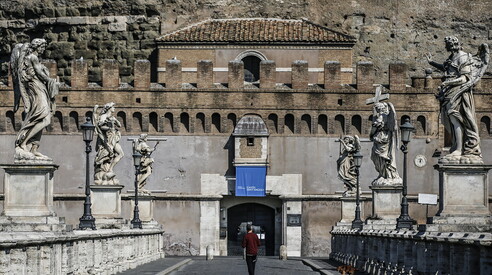A Moveable Feast at Castel Sant'Angelo: After D&G, Operacamion arrives with "Tosca."


Ansa photo
in Rome
Directed by Manu Lalli and the talents of the Teatro dell'Opera bring opera back to the people, with free, traveling shows in the less central neighborhoods of Rome. Starting in September.
Where Dolce & Gabbana showed two nights ago, on the Pons Aelius in front of Castel Sant'Angelo (we won't say anything about the golden armor on the peplums at the presentation in the Roman Forum: the Roman statuary was just as kitsch and brightly colored; in short, in many ways this collection was even philological, not to mention the references to Danilo Donati's papier-mâché and fairy-light costumes from the famous ecclesiastical fashion show in Federico Fellini's "Roma," echoed in the Alta Sartoria collection presented on Tuesday evening), Operacamion will arrive in September, a praiseworthy initiative by the City of Rome that until now has brought free opera, from "The Barber of Seville" to "Don Giovanni," to the squares of the less central municipalities, stopping off in Primavalle and La Storta.
This too, if you look closely, is a philological operation because at the origins of our commedia dell'arte or commedia degli Zanni, from the famous first family of professional itinerants, there was this: carts on which two axles were mounted and comedies and dramas were performed according to a script, in noble palaces but also in the courts, the costumes stuffed haphazardly in the "actor's trunk", many fixed masks, audiences standing or sitting on stools brought from home, exactly like now when, they say, it's fantastic to see spectators arriving with picnic lunches, exactly like at Glyndebourne (here more pizza, there more strawberries and sandwiches, but you know what I mean). Once the tour of the “Barbiere” is over, from mid-September the director Manu Lalli will resume the journey with the opera that inevitably recalls the Castle, that is “Tosca” by Giacomo Puccini, with a similar adaptation (singing in a van is not like doing it in the theater, you have to apply important adjustments to the direction) and essentially the same singing company, made up largely of the new names of the “Fabbrica” Young Artist Program of the Teatro dell’Opera di Roma which, in addition to having announced through the voice of the superintendent Francesco Giambrone an excellent program for the 2025-2026 season (it opens on November 27 with “Lohengrin” by Richard Wagner which returns to the Costanzi after a fifty-year absence, directed by Damiano Michieletto, with the musical direction of Michele Mariotti, Mattia Palma as dramaturgy and the tenor Dmitry Khorchak who will sing the “mai devi domandarmi”, fatal for every couple), is leveraging a 2024 budget in the black for the eleventh year A consecutive statement to explain and anticipate the new commissions: an average capacity of 88 percent, €14.5 million in box office receipts, and a 13.9 percent increase in overall attendance are reflected in the allocations announced by Deputy Minister of Culture Gianmarco Mazzi: approximately €24 million in 2024, in addition to €2 million from the Lazio Region and €18 million from the Municipality of Rome, earmarked for the new building in Tor Marancia, which by 2028 will become the new headquarters of the School of Dance, named after the great, relentless Jia Ruskaia.
The program includes thirteen more evenings than last season, a three-year partnership agreement with the Teatro di Roma, collaborations with Musica per Roma and the Accademia Nazionale di Santa Cecilia and the Teatro di Roma, and two new commissions, including the new Italian version of “Inferno” by composer Lucia Ronchetti, former director of the Venice Music Biennale, with a staging by David Hermann, making its debut in Rome, and costumes by Maria Grazia Chiuri, who, after purchasing and restoring the Teatro della Cometa, is rightly expanding her skills and knowledge beyond fashion.
More on these topics:
ilmanifesto




